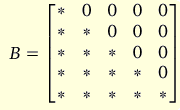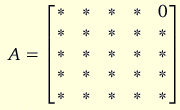There are a number of over-identifying restrictions that are theoretically legal but which SVAR can't always use. In particular, when the method of estimation is based on conditioning on C, i.e., the reduced form parameters, when estimating B then certain restrictions on A are not legal as they would force B to be singular.
A very simple example of that is the following. Suppose we take the following structure for the B matrix:

That is, a recursive structure for the contemporaneous effects. Furthermore, suppose we wish to impose the following over-identifying restriction on A=C*B:

In theory there's nothing wrong with the over-identified 0 in A(1,5). However, when C is taken as given this imposes an illegal restriction on B. To see this, note that:
![]()
where C(i,:) is the i:th row of C and B(:,j) is the j:th column of B. Since B is required to be of full rank it follows that C(1,5)=0 is required for A(1,5)=0 to hold. However, when C is taken as given there's no guarantee that C(1,5) will be equal to 0. In that case, A(1,5)=0 can only hold if B(5,5)=0. But this would make the B matrix singular, which is not allowed. Hence, as long as C is taken as given the over-identifying restriction A(1,5)=0 is not legal and SVAR will tell you so.
One solution to this problem is to estimate C under the restriction that C(1,5)=0. SVAR allows for such restrictions since version 0.21. Alternatively, you may wish to estimate C and B simultaneously. For the above case that would mean to estimate the reduced form parameters conditional on C(1,5)=0 when B is estimated to have the recursive structure above. You can control this type of behavior by making the appropriate selection in the Method section (see Method) on the Preferences dialog. The case of estimation of B conditional on the reduced form parameters is discussed by Vlaar (2004), and relies on results from Amisano and Giannini (1997). The case of simultaneous estimation of all the structural model's parameters has yet to be documented.


